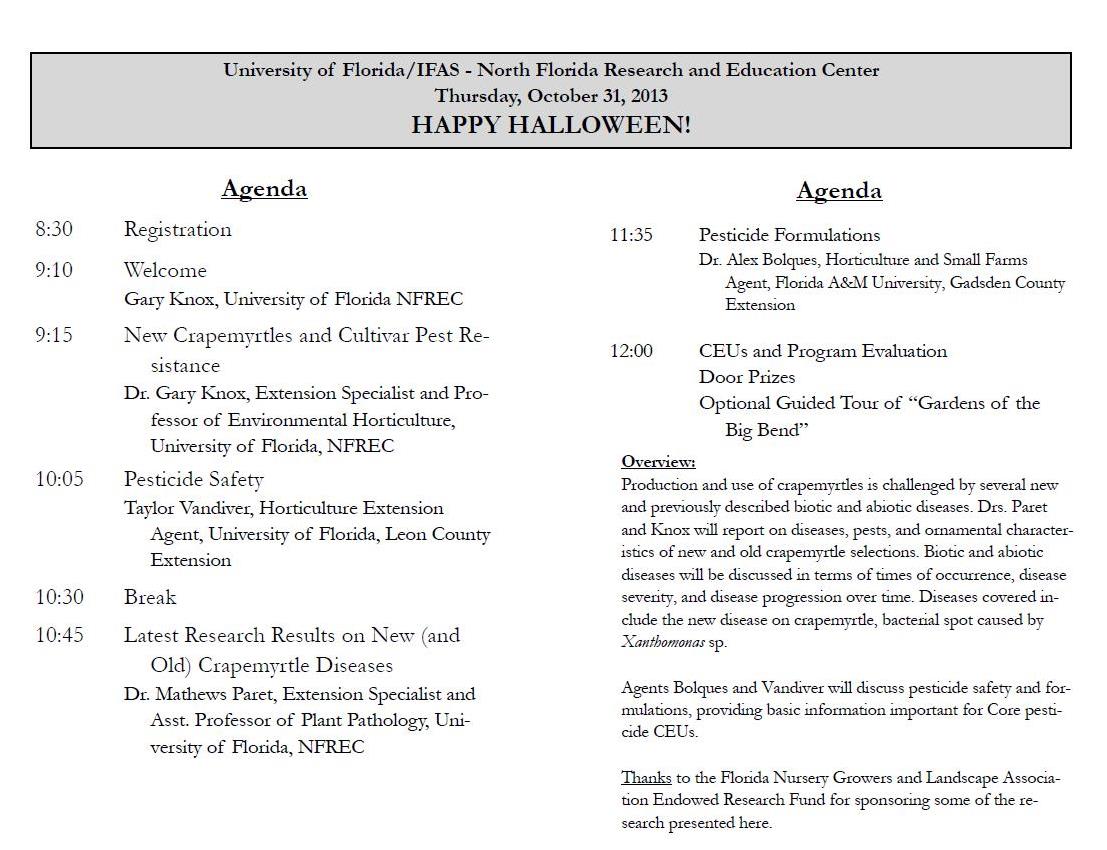by Beth Bolles | Nov 11, 2013
Fall color in the Florida landscape may be a little different than more northern areas but it is just as dramatic with the right plant selections. One of the favorite perennials that is in peak bloom right now is the Cassia or butterfly plant, Cassia bicapsularis. Grown for its showy bright yellow flowers, this soft-wooded perennial can be a garden accent when grown as a small tree. Plants normally grows as a multi-stemmed plant with a vase shape or rounded canopy. Size ranges from 5-10 feet in height and the best flowering is when plants receive full sun.
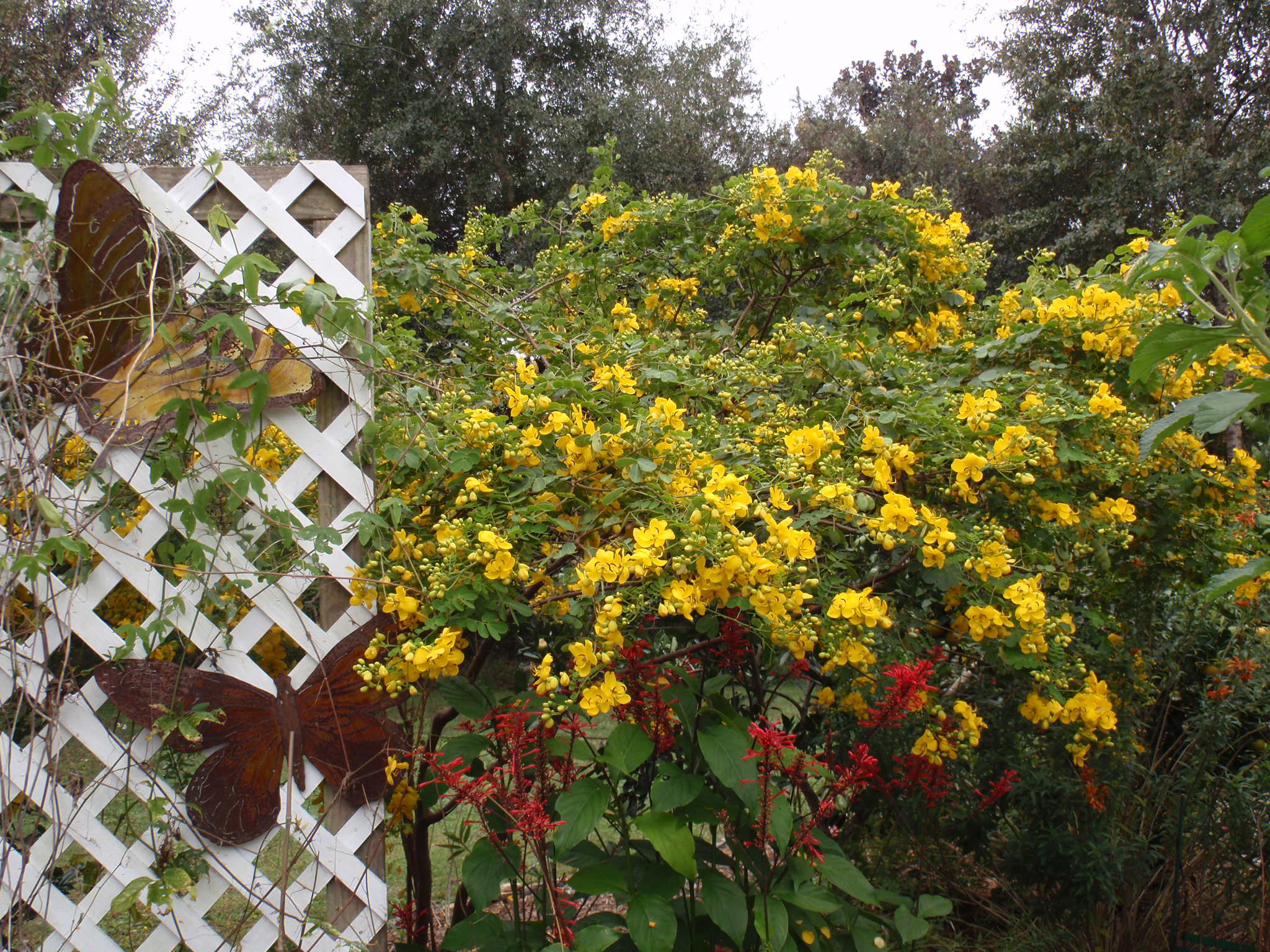
An added benefit of this species of cassia is that it can serve as a host for sulfur butterflies. Blooms will often last until first frost and plants may be injured by freezing temperatures. Homeowners will cut back cold damaged stems and wait for regrowth in the spring. During the growing season, larger plants may need support and summer storms can break some branches. Despite these issues, the fall flower show makes this a highlight in a garden. Learn more about this cassia from the University of Florida IFAS Extension.
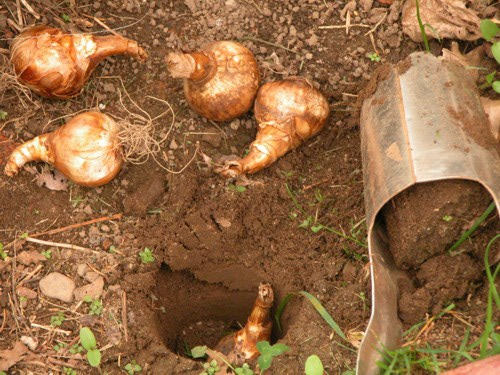
by | Oct 7, 2013
Gardeners may wonder why spring flowering bulbs are a timely topic now when fall is tip-toeing in, but as with most things in horticulture, there is a method to the madness. While many gardeners have become accustomed to running out to the local garden center and buying flats or pots of blooming bedding plants to create “instant gardens”, this last-minute approach simply does not and will not work when spring-flowering bulbs are desired in the landscape. So procrastinators beware! If beautiful beds of daffodils, tulips or Dutch irises are wanted next spring, now is the time to act, not next spring when everyone else’s are blooming.
Spring-flowering bulbs are generally defined as those that bloom here in north Florida between February and April. Information is available dividing these bulbs into categories based on when they bloom in the spring – such as very early, early, mid-season, late and very late. This will allow the garden to be in flower over a longer period during the season.
When buying bulbs, purchase the highest quality stock possible. The quality of the bulb correlates directly to the quality of the blooms. Selecting loose bulbs at a local garden center is like choosing produce at the supermarket. Pick the largest, plumpest bulbs that are firm with no obvious cuts, soft spots or rot. When ordering from a catalog, do it as soon as possible and generally choose the larger sizes when offered.
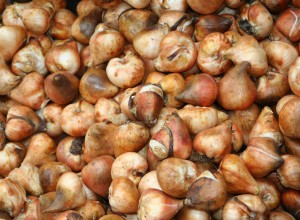
Be picky, look for high quality bulbs.
Choose selections wisely as the flowers of many bulbs do not last an especially long time. For example, while a tulip is a great bulb and an extremely attractive flower, it produces one flower that lasts about seven to ten days and then just like that, it’s done. Ranunculus, on the other hand, can bloom over a four- to six-week period. One thing to expect across the board, however, is the price for color from bulbs is going to be higher than for longer-flowering cool-season bedding plants like pansies and dianthus. If gardening budgets are limited, use spring bulbs more for embellishment and let cool season bedding plants provide the primary floral display.
Obtaining a nice display of spring flowering bulbs depends upon where and how they are planted. Good drainage, part to full sun and moderately fertile soil are all that are needed for bulbs to do well. The average landscape bed generally provides adequate drainage, but avoid low spots that tend to stay moist as this will cause bulbs to rot in a hurry. If drainage is in doubt, plant in raised beds. Choose a spot where there is some shade from the afternoon sun, this allows the flowers to last a little longer, especially if the spring weather turns warm.
It is important to plant bulbs at the proper depth. A rule of thumb is to plant bulbs at a depth equal to twice their height. This far south we generally don’t plant bulbs quite as deep as standard recommendations. Smaller bulbs are planted about 1 or 2 inches deep while larger bulbs are planted about 5 inches deep. Dig individual holes the proper depth, or excavate out, the area to be planted, to the recommended depth and plant all of the bulbs at once.
Once the bulbs are in the ground, plant over them with low growing cool season annuals, such as alyssum, violas, lobelia or pansies. Be careful not to disturb the bulbs. The annuals cover the bare soil and provide color before, during and after the bulbs bloom. Make sure the bulbs will produce blooms that are taller than the annuals, and make sure the colors of the annual flowers contrast with or compliment the flowers of the bulbs in a pleasant way.
Although the proper time to plant most bulbs is October and November, there are a couple of notable exceptions. Tulips and hyacinths will perform much better if they are refrigerated at least six weeks in the vegetable bin of your refrigerator prior to planting (storing longer than six weeks is better) starting now. Store them in paper or net bags (well labeled.) The paper or net allows excellent air circulation that in turn will decrease rot. Avoid storing them near apples and other fruit as these fruit produce a plant hormone called ethylene that can severely alter everything from the time a bulb will bloom to shape, to survival. Plant them in late December or early January when the soil has had a chance to get cold.
Many of the spring bulbs available locally or in catalogs will only bloom reliably for us their first year. Some of the favorites include: tulip, grape hyacinth, crocus, hyacinth, ranunculus, anemone, scilla, freesia, ixia, sparaxis and ornithogalum.
The following are some of the spring bulbs that tend to be reliably long-lived in north Florida and should bloom for several years at least: Narcissus cultivars such as paperwhites, Chinese Sacred Lily, Soleil d’Or, Grand Primo, Cheerfulness, jonquils, Sweetness, Trevethian, Peeping Tom, February Gold, Thalia, Ice Wings, Petrel and larger flowered daffodil cultivars such as Ice Follies, Unsurpassable, Carlton and Fortune.
Other reliable re-blooming bulbs include snowflake (Leucojum aestivum), some flowering onions (Allium neapolitanum, Allium drummondii), ground orchid (Bletilla striata), amaryllis (Hippeastrum species and hybrids), Spanish bluebells (Hyacinthoides hispanica), spring star flower (Ipheion uniflorum), Dutch iris (Iris x hollandica) and Easter lily (Lilium longiflorum).
You can also find an excellent publication written by Dr. Gary Knox on low maintenance bulbs at UF IFAS Extension’s EDIS website.
by Eddie Powell | Sep 30, 2013
With autumn fast approaching, many landowners are looking to add fall color to their landscapes. Unfortunately, many will choose tree varieties based on their fall foliage rather than the possibility of it being an invasive species. One tree that provides beautiful fall color is the Chinese Tallow tree (Sapium sebiferum (L.) also known as the Popcorn Tree.
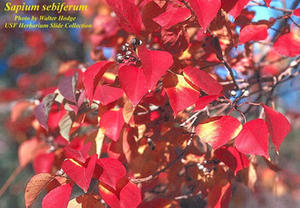
Image Courtesy: Florida Department of Agriculture and Consumer Services, Division of Plant Industry
The Chinese Tallow is a fast growing deciduous tree. It can reach heights of 30 feet and its seeds resemble popcorn, hence the colloquial name. These popcorn shaped seeds, which can be spread by animals, and the root system sprouts make it very hard to control this non-native tree. It has spread to every coastal state from North Carolina to Texas, and as far inland as Arkansas. In Florida it has been found as far south as Tampa.
The Chinese Tallow was listed in Florida as a noxious weed in 1998, which means that possession with the intent to sell, transport, or plant is illegal in the State of Florida. Unfortunately, this invasive tree is still being found in home landscapes due to its ability to reproduce rapidly, create great shade and deliver beautiful, reddish fall leaves.
So even though the Chinese tallow has great fall foliage there are too many problems that come along with it to offer a recommendation. To read more on how to control Chinese tallow check out this fact sheet from the UF IFAS Center of Aquatic and Invasive Plants.
If fall color is important, there are many native species to choose from. To learn more about non-invasive native landscape plants with fall color, check out this publication on Florida native plants. It lists the Sweetgum, a native that is capable of producing great fall color.

by | Sep 16, 2013
While the recently passed Labor Day is often is touted as the traditional “end of summer,” according to the calendar, fall officially will begin with the fall equinox on Sept. 22nd at 4:44 EDT. In north Florida, however, we know good and well that our summer season extends a good bit longer.
Still, even if it just feels right, there is something going on now. When you walk out in the morning, the air feels just a bit more comfortable. The days are getting shorter, and that is beginning to have an effect. Perhaps it’s just wishful thinking, but if you squint just right, you can ALMOST see the end of our long and brutally hot summer.
The word “fall” commonly conjures up images of harvest, falling leaves, the end of the growing season and the beginning of dormancy leading into winter. For gardeners in North Florida, however, the traditional fall period is not a time of winding things down in the garden or even landscape but of revival and renewed effort. It’s a time when we finally can get back into outside and enjoy ourselves as the debilitating heat of summer starts to lose its grip on the weather.
For the next couple of months we will experience a gradual shift to milder weather. There will be cool spells followed by decidedly hot, summer-like weather, but as we move into late October, cooler weather will begin to dominate the scene. Not until mid-to late November do we generally experience the nippy cold weather and changing leaves that tell us, yes, indeed, fall has finally arrived.
One thing you that you might notice that may surprise you may be an increase of vigor in your warm-season bedding plants in September. Even heat-tolerant flowers do not always look their best in August.
Since shorter days mean fewer hours of intense heat, even though the daytime highs may stay about the same, plants begin to experience less stress. This encourages a “second wind”, if you will, in the flower garden that may last well into October or early November. Given this, consider cutting back some of your summer bedding plants and flowers that have grown tall and leggy over the just passed long growing season. This should be done in by the second or third week in September at the latest – and generally involves cutting plants back about one-third to one-half their height.
While you’re at it, it might be a good idea to impose some order on those overgrown flower beds. In addition to cutting back, groom plantings to remove dead flowers and unattractive foliage.
If plants are leaning or have fallen over onto nearby neighbors, prop them up or stake them so they will stand upright. Just about every year at this time I find the remains of some unfortunate plant that was overwhelmed when larger, more vigorous, nearby plants leaned over it.
In addition, if you haven’t done so already, gently trim your everblooming rose bushes, including such popular groups as Hybrid Teas, Grandifloras, Floribundas, Miniatures, Teas, Polyanthas, Bourbons, Chinas and English roses, to name just a few. This should be a very light trimming, little more than deadheading, since the main pruning of everblooming types is done in mid February. On the other hand, keep in mind that many old-fashioned climbers, ramblers, Lady Banks roses and some bush roses that bloom heavily only in spring to early summer will bloom next year on the growth they made this summer. Those roses should not be cut back at all now.
Even though you can get back into the garden to work, it is still too early to plant hardy trees, shrubs, ground covers and vines in the landscape. Temperatures in the 80s and 90s likely will be common in September, and that is still too stressful for new plantings. Wait at least until the cooler weather of October, since the ideal planting season for hardy trees, shrubs and ground covers really is from November through February. And for those that like to plant pecan trees, these are often done in bare root when the trunk of the tree is about the size of a pencil. These MUST be done when completely dormant or you will not have a successful outcome.

While Fall is for Planting, be sure that you don’t start too early!
Keep in mind that even though they will begin to show up in area nurseries this month, it is also is too early to plant cool-season bedding plants. Even if you have an area where your summer flowers have finished and have been removed, it is still too hot to plant most cool-season bedding plants. Instead mulch the area now and wait until the reliably cooler weather of October or November before you plant your bedding plants.
Spring-flowering bulbs, such as tulips and daffodils, become available this month, but there is absolutely no hurry to plant them. Purchase them if you like while the selection is good, but wait to plant your spring flowering bulbs from mid-October through early December.
Keep in mind that insects and diseases stay active through the fall, so continue to control any pest problems with timely applications of the proper material. In addition, don’t forget, now as always, water well during dry periods, and you should have an excellent crop of flowers in October through November.
I guess if you think about it, it’s best to say that Labor Day really marks that time in north Florida when we can anticipate the soon-to-arrive milder weather and look forward to enjoying the delights of gardening over the next few months. When the fall equinox arrives later this month, don’t get carried away. For us, summer will still be lingering for a little while longer.
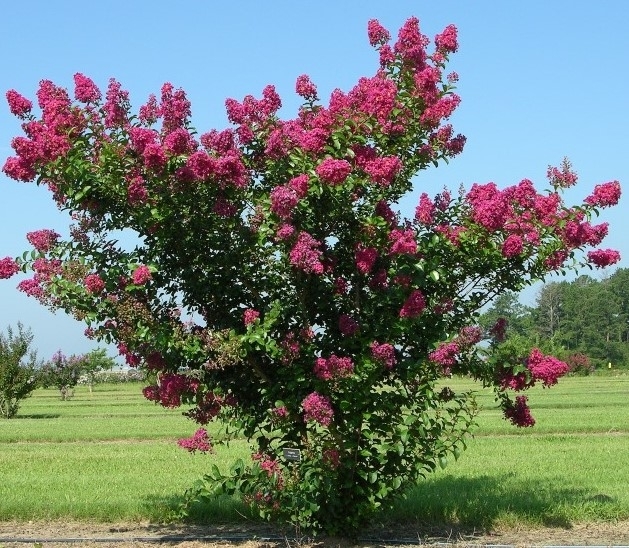
by Gary Knox | Jul 29, 2013
Crapemyrtle flowering has been spectacular this year!
While most other garden plants droop from summer’s heat, humidity and heavy rains, crapemyrtle thrives and puts on an outstanding show of flowers all summer and fall. Thanks to modern breeders, there are all sizes of improved hybrid crapemyrtles with flower colors of lavender, purple, white, pink, or red.
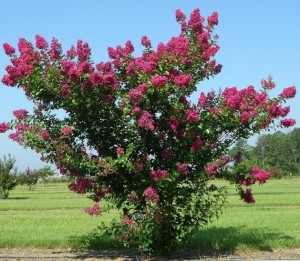
Crapemyrtle Cultivar: ‘Tonto’
Image Credit: Gary Knox
Just say “No” to Pruning
- Crapemyrtle varieties come in tree-size, patio tree and shrub categories.
-
Tree-size crapemyrtles grow 25 ft. tall and are ideal as flowering trees. Patio tree-form plants (up to 12 ft.) are beautiful as small, flowering specimen plants near patios, walkways, and entrances. Shrub forms (up to 6 ft.) make excellent accents in a shrub border and smaller types are effective as large groundcovers or container plants.
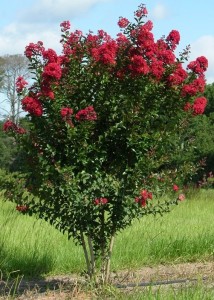
Crapemyrtle Cultivar: ‘Red Rocket’
Image Credit: Gary Knox
- Make sure you buy the right size crapemyrtle for your home. Don’t make the mistake of planting a tree-size crapemyrtle in an area too small for its ultimate size, or you’ll find yourself pruning it hard – and often – to keep it from out-growing its place.
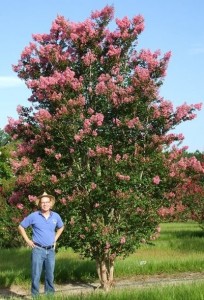
Crapemyrtle Cultivar: ‘Sioux’
Image Credit: Gary Knox
Recommended Varieties
- Some of the best tree-size (25 ft.) types are Natchez (white), Red Rocket® (red), Sioux (pink) and Apalachee (lavender). Superior patio tree crapemyrtles (12 ft.) are Acoma (white), Cheyenne (true red), Tonto (fuchsia red), Hopi (pink) and Catawba (purple). Smaller shrub (6 ft.) crapemyrtles are hard to find, but Cherry Dazzle® is a nice mounding red and Pixie White and New Orleans (purple) are good selections.
Planting and Garden Care
- When it comes to planting, crapemyrtle is very tolerant and forgiving with three exceptions. First, crapemyrtle needs sun to flower freely, so plant it in a site receiving at least six hours of direct sunlight each day. Secondly, crapemyrtle will not grow in wet soils. Finally, never plant crapemyrtle too deep — if you do so, it will punish you by not flowering for years and years. Planting too deep literally smothers the roots, requiring the crapemyrtle to regenerate a new root system in the soil above.
- Crapemyrtle is very drought tolerant and almost seems to thrive on neglect. On the other hand, regular watering and fertilizer will help crapemyrtle grow faster and bigger.
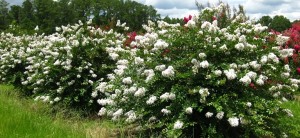
Crapemyrtle Cultivar: ‘Acoma’
Image Credit: Gary Knox
More Beauty on the Way!
- Breeders are continuing to improve and introduce new crapemyrtles. Many new varieties were released in the last couple years. In particular, watch for new types with purple-burgundy leaf color all summer long! Time will tell which new ones grow best in Northwest Florida. Stay tuned as the world of crapemyrtle continues to evolve and improve!
*Gary Knox is Professor of Environmental Horticulture with the University of Florida. He is stationed at the North Florida Research and Education Center in Quincy, where he evaluates more than 100 cultivars of crapemyrtle.




